|
Continuing the Time Travel: 75 Years in Events.
Started in NetLetter #1419.
1949 - Women learn to travel light.
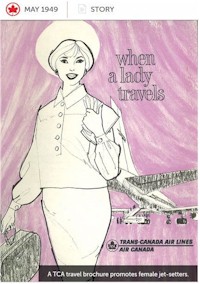 Miss Gwen Robyns, a British journalist, finishes the last leg of a 45,866 - kilometre tour around the globe on a TCA North Star in May 1949. Miss Gwen Robyns, a British journalist, finishes the last leg of a 45,866 - kilometre tour around the globe on a TCA North Star in May 1949.
The flight is to prove that women can travel the world "fantastically easily," even with the 66-pound baggage allocation.
Her luggage includes 12 cotton and wool dresses, two suits, a coat and a one-ounce cashmere sweater. Her lightweight shoes are made by the Queen's shoemaker.
|
|
|
Breakfast on the fly.
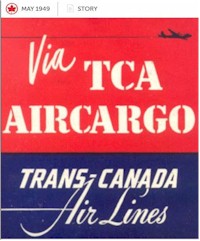 In May 1949, 30,000 Grade A eggs and 2,500 pounds of bacon are sent by James A. Ogilvy to friends and relatives in the U.K., just in time for Easter breakfast. In May 1949, 30,000 Grade A eggs and 2,500 pounds of bacon are sent by James A. Ogilvy to friends and relatives in the U.K., just in time for Easter breakfast.
They are flown by TCA’s Aircargo service, aboard a North Star.
(Source:http://moments.aircanada.com/timeline)
(More next NetLetter - eds)
|
|
|
An old timer comes home.
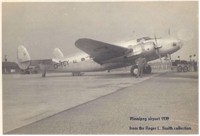 Grant Corriveau, a First Officer based at Dorval, happened to be visiting the Canadian Museum of Flight in Surrey, BC, during 1987, when a new addition to its collection arrived. Grant Corriveau, a First Officer based at Dorval, happened to be visiting the Canadian Museum of Flight in Surrey, BC, during 1987, when a new addition to its collection arrived.
The new arrival was CF-TCY, a Lockheed 14 which was once a member of the company's fleet. Here is a photo as it was in Winnipeg 1929.
He writes: "It is now sporting a camouflage paint job and is aptly nicknamed 'Ole Boomerang'.
|
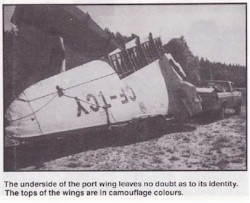 |
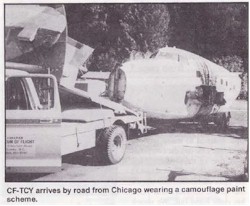 |
|
Apparently Air Canada contributed to the cost of moving what's left of TCY from somewhere in Chicago to the museum's site. Funds are now needed to pay for a restoration project to put the aircraft into 'Show' condition. The museum is hoping to get some help from the employees of Air Canada.
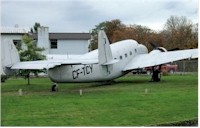 Here is a photo at it is after restoration. Here is a photo at it is after restoration.
His interest aroused, Grant did a little research on the Lockheed 14 and found the following quotation in Larry Milberry's book "Aviation in Canada" (McGraw-Hill Ryerson, 1979 page 55)
By the end of 1938 TCA's fleet had grown to include five 10-passenger Lockheed Electra’s and 10 larger Lockheed 14's. With a cruise speed of 207 mph, the L-14 was the world's fastest airliner. Bringing this modern equipment into service was a real challenge.
In the case of the L-14, TCA pilots had a tricky airplane to master. This has been described by Z. L. Leigh who took delivery of the first one for TCA: "We spent two days in Reno trying to fly the aircraft. The test pilots weren't too good at checking us out, and we found that this machine was one which had to be landed on its main wheels with its tail near the flying position, otherwise it became very troublesome".
At that time, in general, we landed most of our aircraft, including our Lockheed 10A's in a three point position, that is with the main wheels and the tail wheel touching the ground approximately together. Initially the new procedure of a "wheel landing" was awkward for us.
"In my own case I bounced my aircraft badly around the Reno field, sometimes almost digging wing tips into the ground. Slim Lewis was having exactly the same trouble.
In addition, the test pilots would not take us up and check us out in stalling the aircraft because they said that they had tried it once or twice and that was enough.
They told us that it was so violent in a stall that it flipped right over on its back. It was apparent that we were going to have to find out how to land the thing properly, and to stall it at altitude all by ourselves." Sometime later, back in Winnipeg, Leigh and Lewis accepted the fact that they were going to have to confront the L-14 in a stall. They had by this time learned to make smooth landings. One day the two pilots took one of their aircraft up.
Leigh recalls that, "At about 12 or 13 thousand feet Slim tapped me on the shoulder and stuck his right hand out. We shook hands quietly, then Slim started to pull the nose up and throttle gently back. The aircraft felt very smooth, no shudders, she flipped halfway over violently. Loose things flew around a bit but Slim shoved the nose down and she straightened out.
It was a pretty rough stall but not so bad as we had been led to believe. He did a couple more and then we changed seats and I did about three of them. We were as pleased as two small boys. We could now get on with our job of teaching the others with confidence." In time the peculiarities of the L-14 were understood fully and TCA pilots were flying their new aircraft with skill and assurance.
 Source for text and photos: Horizons issue dated December 1987 (Click icon to view). Source for text and photos: Horizons issue dated December 1987 (Click icon to view).
Although the article is as it appears in the source issue of Horizons, it does not seem to be historically accurate.
|
|
Ken Pickford advises:
The submitter of that item has mis-identified the aircraft as a Lockheed 14. CF-TCY in the photo that went to the museum is very definitely a Lockheed 18 (Lodestar) not a Lockheed 14 (Super Electra).
TCA had both. References in the earlier NetLetters mentioned at the end correctly refer to it as L-18. The L-18 was based on the L-14 but was about 6 feet longer, permitting 2 more rows of seats, and had changes to the wing and tail. It's easy to confuse them in photos. Windows on L-18 are more widely spaced than on L-14.
The year 1929 year at the end is obviously wrong; 1939 would probably have been correct if it was an L-14, but it's wrong for the aircraft being discussed since the L-18 wasn't certified and didn't go into airline service until 1940. Note the date on the photo itself reads 1939 which is also wrong since it's an L-18. If you can find a source indicating when CF-TCY was delivered you could amend it, but it's definitely not before 1940.
(Terry Baker did some research and found that CF-TCY was delivered February 14, 1941 and modified January 12, 1943, as per the Air Canada Pocket Guide.
Since the aircraft is a Lockheed 18, reference to the submitter's research on the Lockheed 14, while interesting, isn't relevant to CF-TCY.
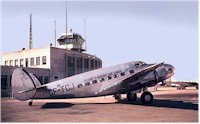 The lengthy book excerpt regarding the handling issues on the early TCA L-14 (pictured at left) flights also isn't very relevant. The lengthy book excerpt regarding the handling issues on the early TCA L-14 (pictured at left) flights also isn't very relevant.
However, it is interesting so perhaps leave it in provided the text makes it clear that it's referring to the earlier L-14 Super Electra, not the L-18 Lodestar.
|
|
(Additional reference at canadianflight.org/content/lockheed-lodestar)
Previously, information on CF-TCY was in NetLetters # 996 November 10, 2007, NL #1004 January 5, 2008 and NL #1026 June 23, 2008.
Do any of our readers have comments to add?
|
|
|
 Extracted from the "Horizons" magazine. Extracted from the "Horizons" magazine.
Issue dated February 1988.
|
|
Sunshine travels north.
The Barbados office sponsored a group of fellow employees in the 1988 Toronto Marathon.
The "Air Canada Barbados Sunshine Team" was made up of two women and three men. All of them completed the 26-mile, 385-yard course with good times, although all agreed that after running in the warm Barbados sunshine. Toronto's near-zero temperatures slowed their times somewhat.
Nevertheless, the team, which included three first-time marathoners, were very pleased with the results and expressed much appreciation to Air Canada for its support.
Now that they have recovered from their sore, stiff muscles, the members of the "Air Canada Barbados Sunshine Team" are back in training and hope to compete in another running event before too long.
In the photo: John Buchanan, Manager, Barbados, left, presents tickets to the team prior to their departure for Toronto.
From the left are: David Edwards. Wendy Webster, Solomon Ali. David Neblett, Jill Sanguinette and Omar Rahaman.
|
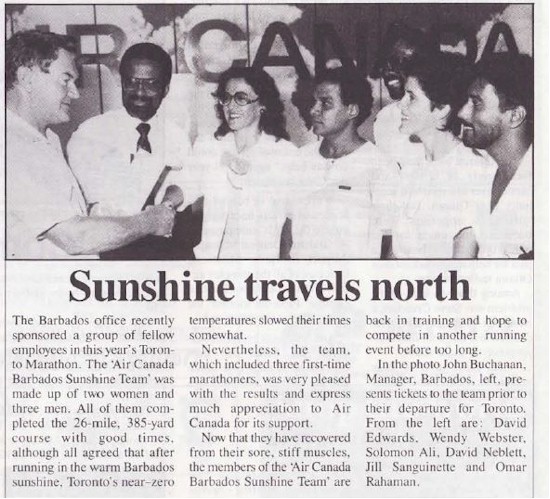 |










 Extracted from the "Horizons" magazine.
Extracted from the "Horizons" magazine.